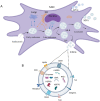Mesenchymal stem cell-derived extracellular vesicles for immunomodulation and regeneration: a next generation therapeutic tool?
- PMID: 35787632
- PMCID: PMC9252569
- DOI: 10.1038/s41419-022-05034-x
Mesenchymal stem cell-derived extracellular vesicles for immunomodulation and regeneration: a next generation therapeutic tool?
Abstract
Mesenchymal stem cells (MSCs) can be widely isolated from various tissues including bone marrow, umbilical cord, and adipose tissue, with the potential for self-renewal and multipotent differentiation. There is compelling evidence that the therapeutic effect of MSCs mainly depends on their paracrine action. Extracellular vesicles (EVs) are fundamental paracrine effectors of MSCs and play a crucial role in intercellular communication, existing in various body fluids and cell supernatants. Since MSC-derived EVs retain the function of protocells and have lower immunogenicity, they have a wide range of prospective therapeutic applications with advantages over cell therapy. We describe some characteristics of MSC-EVs, and discuss their role in immune regulation and regeneration, with emphasis on the molecular mechanism and application of MSC-EVs in the treatment of fibrosis and support tissue repair. We also highlight current challenges in the clinical application of MSC-EVs and potential ways to overcome the problem of quality heterogeneity.
© 2022. The Author(s).
Conflict of interest statement
The authors declare no competing interests.
Figures
References
Publication types
MeSH terms
LinkOut - more resources
Full Text Sources


